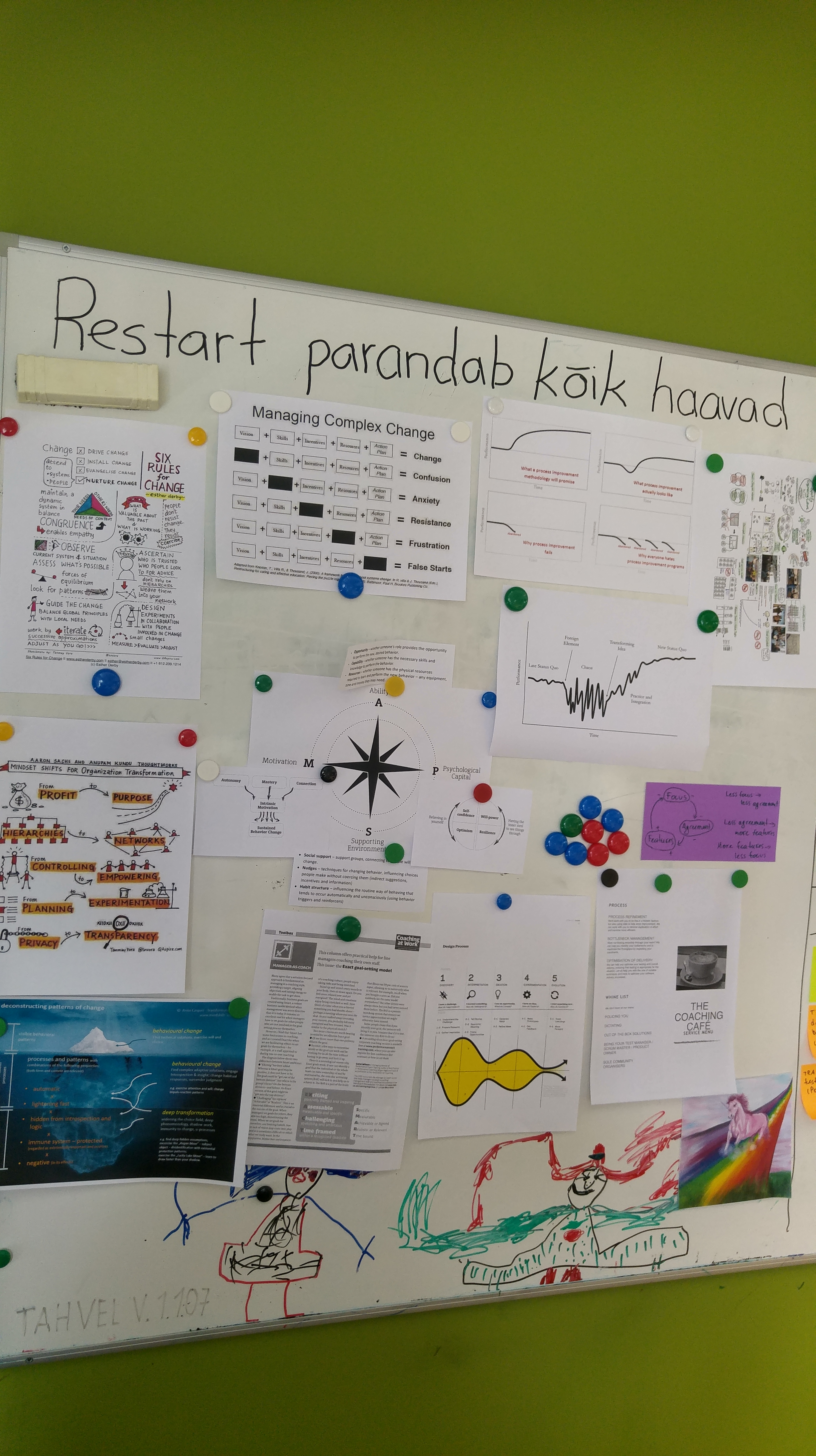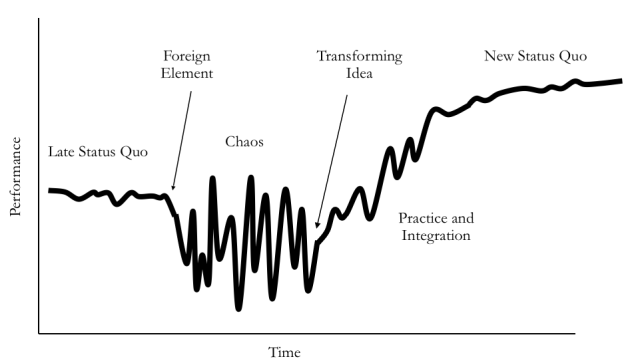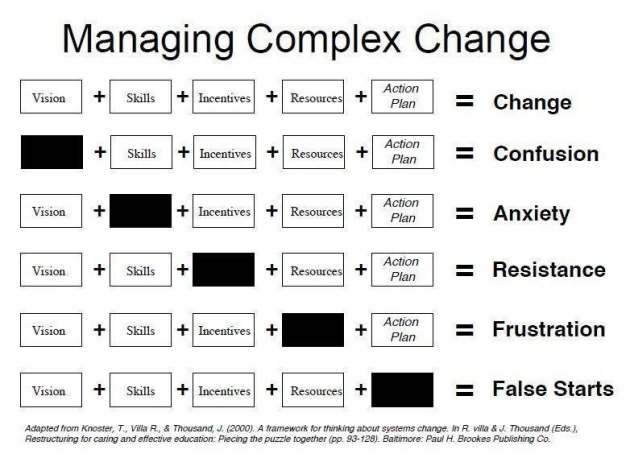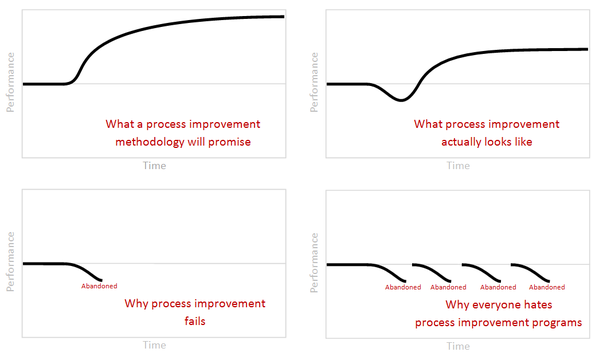Quite OK, thanks for asking. I feel like this writing exercise helps me clear my head a bit.
Many have learned by now that “all models are wrong but some are useful” – a saying attributed to the statistician George Box. In my quest for trying to understand an organization and its dynamics, I’ve come across a few models that help me in various ways. At the end of my last blog post I said I will cover “change and a context model for affecting behavior” next. That was a bit premature as I developed another idea of what to show you before I talk about a specific model. Sorry about that but I’m sure you can wait for that one.
I have created an “inspiration board” that contains images, drawings, and schemas that relate to change one way or another. I am fascinated about the nature of change, how difficult it can be and yet how transformative, how mind boggling can be its effect yet how inspiring its results. I am fascinated by how some people seem to be good at nurturing change for others while some struggle with changing their lives for themselves. We cope and struggle with change in very different ways. I believe a great manager is sensitive to this and develops empathy towards a variety of reactions to change. Because after all, managing nurturing change is the managers’ business.

The title of the board reads “Restart heals all wounds” – written by a colleague who handles our Atlassian stack. The drawings at the bottom and the PFUDOR are not related to the inspiration board.
Satir’s change model

Satir’s change model is a classic, I think. I find the model helpful when discussing the perception of the same situation. Once during a team retrospective, I asked people to mark on the model where they thought we were: in late status quo, in deep chaos or in our way up. It was a way to bring awareness of each others perspective: some felt we were in the middle of chaotic change and were not approaching the end of the tunnel while others felt like it was no big deal and things were stable. That will lead to discussing how your team members react to the same events differently.
When I look at Satir change model, it reminds me to ask myself where I think I am in the process and where others are. Maybe we should have a chat about this? Also, the model reminds me that it may be hard to know when the chaos will come to an end, and that may strain me and others if we pile more change on top of what we’re already going through.
However, I think there’s something that this specific representation of change biases us towards: when you look at it, it hints at the outcome of the change to be “higher” and “better” than what was there before. It may be so. It may not be so. Sometimes people can’t stand to go through the process and quit, there’s a lot of resistance, or the change really hurts the people and the system, so you may end up with lower productivity, satisfaction, what not.
Managing complex change

This table reminds me to think of components of change. Sure, there could be more added to the list. But conceptually, it helps me analyze what pieces I have already thought of, and which I’ve forgotten about. I can say that I have personally experienced many of the emotions or effects and can very much relate to this matrix. For instance, I remember in great detail how I felt when I was trying to “make testing happen” at my previous job. I had the vision, incentives for myself, and some kind of a plan but I felt anxious because I knew I didn’t have much skills or knowledge about testing. I also had very little resources, so I felt like David taking on Goliath. At the same time, there were many who were to be influenced by the change of bringing testing into the organization and they lacked the incentives to seriously give it a try. Hence the resistance and belief in the “good old ways”.
And of course, I’ve had my share of false starts when I haven’t considered putting together a useful plan.
When I look at this model, I also think of the extra stuff in each box that is not spelled out but is there. For example, a vision in my head or on a page is not enough. It needs to be communicated, stories need to be told, discussions need to take place. Skills are not simple matter either: awareness of skills is a big step, teaching and learning new skills is a whole big process on its own.
Interestingly, the matrix is from a book about climate change. Inspiration can be found anywhere!
Process improvement

It’s curious that the top right-hand picture looks similar to Satir change model. They both have the same bias in common, though: that once change is carried through, things will be better.
I realize that the pictures about process change are really simplified. However, I think they illustrate many people’s experience well, even if using anecdotal graphs. When I look at these graphs, they remind me to ask the question “why”. Why have the previous attempts failed? What did the people do and how they approached change? Why did they approach it this way?
I’ve observed that some unwanted effects of change are blamed on the “object of the change” (i.e. the new technology that was introduced “sucked” and wasn’t the right one) while nobody seems to ask if the people introducing the change were skilled at helping to make it happen, nurturing it, and supporting the process.
Through a few more or less painful lessons (and thanks to PSL), I’ve come to understand that just knowing how some new stuff is supposed to be like is not enough. You need to understand process, how to facilitate it, how to support the process to successfully change something. So these graphs also remind me to focus on the process and not “abandon” it.
Just to add another twist, it also reminds me to consider when it might be the time to let go and not be the victim of sunk cost bias.
***
So there ya go. I will cover more pieces of this board in later posts.
What do you use to help you be aware of different aspects of change?
